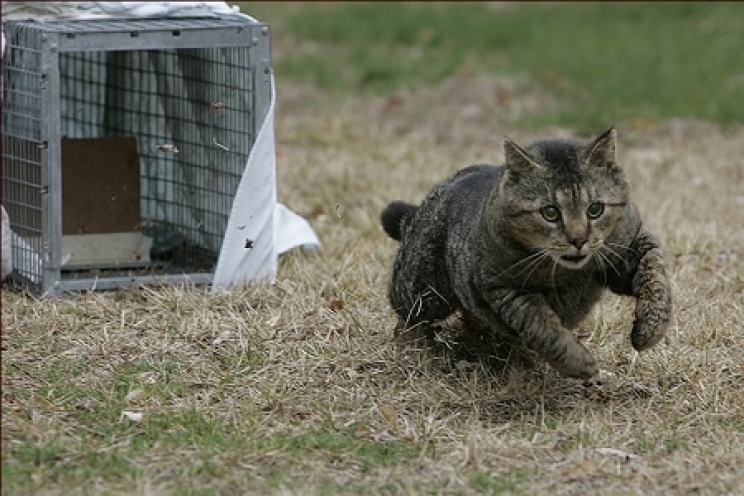Stray cats, tend to be very suspicious. It may happen, however, that they need to be taken to the vet urgently or simply be taken to be able to move them to a new home. But how can we catch a stray cat that does not allow itself to be approached easily?
The situations in which it may be necessary to catch a cat can be many. For example, let's think of the stray sterilization plan promoted by all Italian municipalities. In most cases, these animals are so active and agressive that the only way to take them to the vet is to sedate them. Likewise, stray dogs often fall victim to cars, serial poisoners or the normal dangers of street life, so they may need a visit or intervention from the vet.
Another situation may be that the cat has found a family of his own, but does let anyone get close to him at all.
In all these cases, some techniques can be put into practice, which we will analyse in detail, from the simplest and obvious ones to the most complex.
First, we need to make sure we have plenty of time. So that we can proceed with some indispensable preliminary operations, which in some cases even take several days, to increase the probability of success at the time of capture:
-
 We observe the cat in its environment: to understand the nature of the animal, we will have to see how it behaves, observing him without giving the impression that we are there for him. Further on we might even go a bit closer. Let's not get too close, because it could run away. For example, we can sit nearby, watching it slightly but not too intensely. Did he already become suspicious? He stares at us and seems ready to run away on our first move? He is probably very shy. If, on the other hand, he looks at us from a distance, and he seems calm enough, we could be able to approach him easily;
We observe the cat in its environment: to understand the nature of the animal, we will have to see how it behaves, observing him without giving the impression that we are there for him. Further on we might even go a bit closer. Let's not get too close, because it could run away. For example, we can sit nearby, watching it slightly but not too intensely. Did he already become suspicious? He stares at us and seems ready to run away on our first move? He is probably very shy. If, on the other hand, he looks at us from a distance, and he seems calm enough, we could be able to approach him easily; -
Be friends with him: we must make sure that the cat understands that we do not want to harm him, by calling and trying to address him in a calm and sweet tone of voice. We avoid standing while we do it, it is best to sit or bend on our knees, to seem less imposing. Let's not stare at it for a long time, but close our eyes repeatedly which is a sign of calmness for all cats;
-
"We buy" his trust with food: in the days before the capture - clearly if we have the time - we try to feed him, to make him understand that our intentions are good. Some cats do not approach food if they feel they are in danger, so for the first few times it may be advisable to keep our distance, gradually approaching them when they let us.
All of this may be impossible to put into practice if it is an emergency, for example an injured cat, which in most cases will be too debilitated to escape. In these circumstances, we may therefore have to automatically switch to the capture system.
The ways available to try - and maybe even to succeed - are many, but the most important thing to keep in mind is that cats are not always sweet and cuddly. The more frightened and distrustful he is, the more likely he is to attack us.
So let's get ready with gardener gloves, long-sleeved sweatshirts, blankets and all the less bulky protections that come to mind. We must also prepare the pet carrier that will serve to welcome the cat.
Let's see the various methods available to us to capture the animal:
- Capture with bare hands: highly discouraged in most cases, unless the stray cat already knows us and is perfectly used to being manipulated by humans. In any case, it is always advisable to wear gardener gloves. Alternatively, we can try to grab the cat by standing behind him while he is eating, without picking him up as we would normally do. Rather, let's take it from the "scruff", the accumulation of skin between the shoulder blades, which blocks the animal without causing pain. Of course, we must already have the pet carrier available, to avoid wasting time;
-
Capture with a blanket or net: alternatively, we can try another method which is still not recommended. Let's get a heavy blanket or net, which we will throw at the cat while it is eating. At this point we must have the agility to prevent it from running away whilst we lift it to put it in the carrier;
-
Capture with the pet carrier: this can be a safer and a mostly effective solution. We put a bowl of warm food on the bottom of the container, wait for the cat to enter completely with the whole body and prepare to close it quickly. Some cats, however, may be more agile than us, leaping out at our first attempt;
-
Capture with the cage-trap: it is probably the most suitable method in most cases. Those who need to catch stray animals by profession also adopt it. There are two types of cage-trap, the one with the bait impaled on a small hook and the one with a table on which the food should be placed. In both cases, as soon as the cat touches the food, it will trigger a mechanism that will close the door behind it with a guillotine. It is absolutely not risky and it can even work in our absence, so the cat will feel calmer. However, once the door closes, the cat might react with great fear, trying to free itself in all possible ways.
Given the sad episodes that unfortunately have become increasingly widespread in the last period, we recall that the mistreatment of stray animals is a severely punishable offense. Therefore, the indications given in this article are intended exclusively for all those who have a real need to catch a cat with the sole purpose of treating it or improving the quality of its life, for example by transporting it to a new home.










